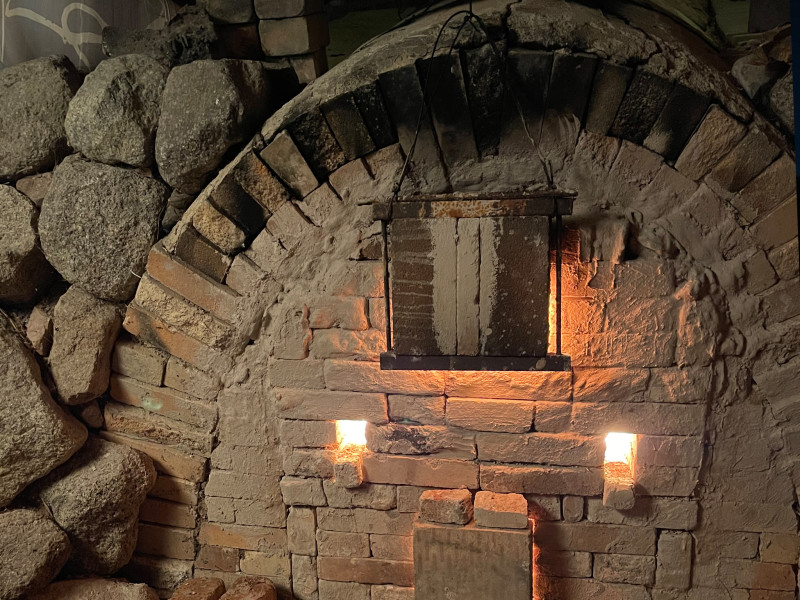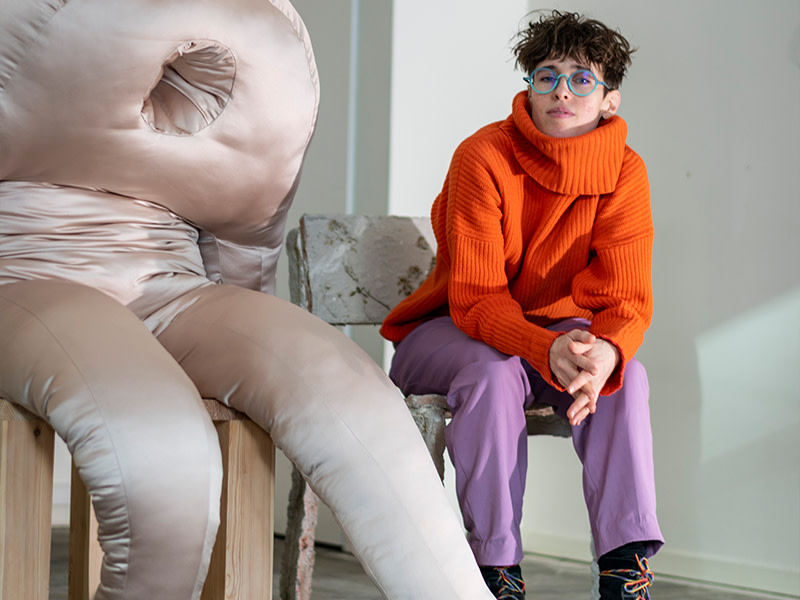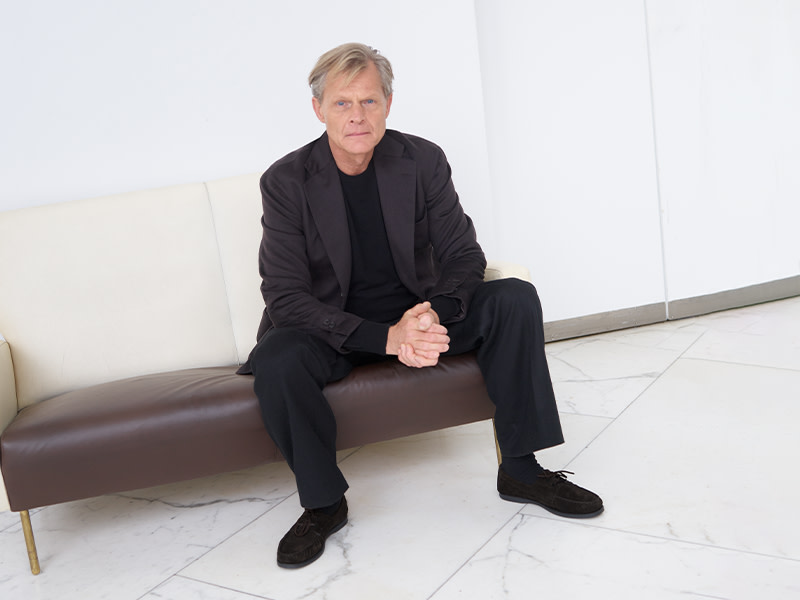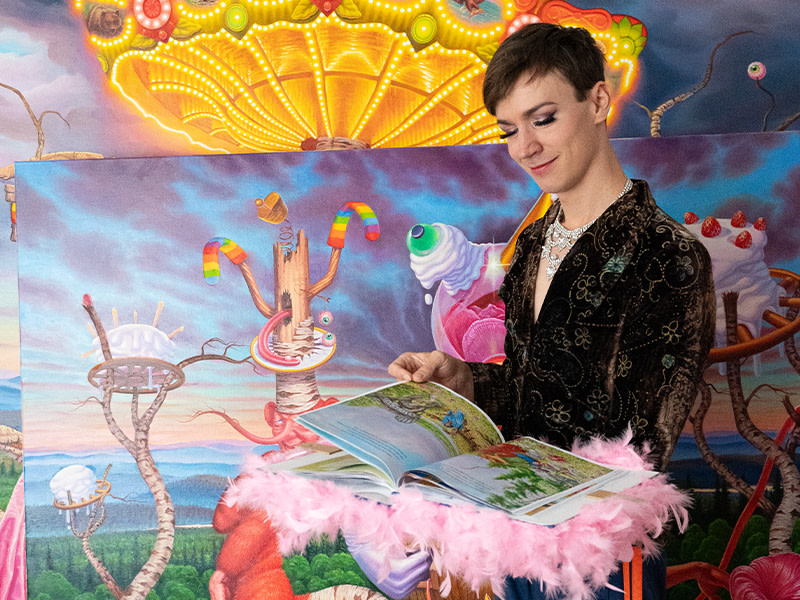Layers upon layers – a conversation with Jesper Waldersten by Lo Hallén
Interview
February 12, 2024
A work by Jesper Waldersten carries stories in abundance, dreams that have been brought to life in layers upon layers. Literally, that is – the artist reuses all his panels and canvases repeatedly and could tell you in detail what is hidden behind the top coat of paint… if he wished to. But no one cares about dreams, according to Waldersten, unless they are reshaped into great tales. ‘I’m often asked how I know it’s time to sign a piece, how I know it’s ready’, he says. ‘It’s when the dream can be recounted.’ The road to a coherent narrative is paved with tranquility, acceleration, destruction, and reconstruction; a narrative observers later are invited to search for independently, through the lens of personal experiences and longings.
During our conversation, Waldersten describes his works, or ‘images’ as he calls them, as characters with traits and fates of their own. Friends that used to reside within him, set free by the twists and turns of the painting process. After that, they are on their own. When the works are finished, Waldersten too is finished with them – the practice, the craft, the solitude in the studio are the essential elements for the artist. In the exhibition Slutet är fantastiskt! opening on February 15th at CFHILL, we get to meet the friends in oil on panel, and one in bronze, that Waldersten just sent off.
I listened to an episode of Tankar för dagen featuring you, from the 15th of January, on Sveriges Radio, where you talk about the studio. In the episode you describe your painting process as free from ideas, a practice that allows you to feel unfettered.
— Yes, in the studio, the painting practice is what’s of value. It doesn’t have to result in a finished piece. Painting is different from my other disciplines; it allows me to relax completely. It’s an exercise, it’s being with myself, venting. Like meditation, almost… or not always. Sometimes, I accelerate. But it’s always undemanding. I have a mantra for my practice, my five K’s under the umbrella of Kreativitet [creativity]. Kravlöshet [free from demand], Kvantitet [quantity], Kaos [chaos], Kunskap [knowledge], and Kärlek [love] guide my process. It’s about the longing for the craft, the tactile, to touch and to move. To be in solitude. I love being by myself.
Does the meeting with the viewer, once the works are exhibited, affect these feelings at all?
— No. One of the human assets, I believe, is the ability to be childish and playful. We must dare to put ourselves out there, saying ‘look, it’s just play’. When all my exhibitions are approaching, I picture this sixteen- or seventeen-year-old, who doesn’t know what they want to do with their life. Yet, they sense there are wonderful things in the world – that’s how I felt at that age. I hope such people stop by the exhibition at CFHILL, maybe just to realize how many different paths one can choose to walk down. With that said, whenever I have given very thorough explanations of the themes in my paintings, it hasn’t worked out. I want the viewer to feel involved, instead, to be the star – I don’t need to describe the concept in exact detail. Still, the discussion and dialogue is important to me. Every time I speak with someone, like with you today, or when I lecture, or meet someone at an opening who asks me questions, I learn about my artistry. Since
I work with the subconscious, especially when painting – I rest, the body, the hand is at work – it’s vital to also articulate where I’m coming from.
Can you explain what it means to work in that way?
— My current creative space, which I have been residing in for some time now, is reminiscent of a forest. I allow myself to get lost. I put myself in a state of mind where the intellect is disconnected, shut off. Except for when I specifically need it, at certain transitions, or when I have to solve problems concerning colors or shading. To describe my creativity, I use an appealing, yet perhaps somewhat inelegant, allegory – it’s like catching butterflies. I go out there and look for them. When I photograph or write, I catch a whole bunch of butterflies. It’s something I did as a child, and I took all of them home to categorize, which I still do metaphorically. Painting takes on another shape in this allegory. During the painting process, everything happens inside the pupa. I’m fully enclosed and can do whatever the hell I want. It may be sad, may be ugly, but I’m there. When I sign the work, the butterfly hatches and takes off. We might not see each other again after that.
Did you always paint?
— Yes, definitely, and I’ve always worked with oil in various ways. Though during the pandemic, I got a chance to delve deeper into painting again. No emails. Normally, seventy percent of my time is spent on this sort of thing – conversing, answering emails, having meetings, preparing for exhibitions. And in comparison, very little actual work in the studio. During the pandemic, I painted a lot and had endless time to do so. I feel like I made technical progress in two years, that would have taken me ten otherwise.
Just because you got some peace and quiet?
— Yes, a focus and calmness I really needed.
Does painting require calmness?
— Yes, it does. It’s ritualistic. It’s about greeting the room. I undress in a certain way. I put on my suit, my uniform – my painting clothes, that is. I arrange things in specific ways. I’m not really sure what will happen or if it will work. But it usually does.
You’re not sure if it will work?
— I paint calmly at times, and painting is generally a slow practice. But I also accelerate. When things don’t go the way I wish, I can get frustrated. Especially on Fridays, if the work during the week hasn’t brought about a butterfly. In that case, I can start working quite aggressively and fast-paced on several paintings at once. Sometimes I just end up ruining all the previous effort I put in, or a piece turns out perfect. I only know for sure when I get back to the studio the following Monday, when panels have dried and pigments have settled, often having forgotten what I did in the rush. At times, it turns out just amazing, but, if you ask me, sometimes it ends up looking like trash. But I find it necessary to provoke chance and chaos, to challenge it.
To create momentum in a slow practice?
— Exactly, there’s a need for the acceleration I mentioned. Serenity requires a punch in the face sometimes. The titles also help with this. In text as a medium there is quickness, wit.
When do you decide on the titles?
— At the end!
It’s how you wrap up?
— Yes. When the work is finished and about to take off, it must receive the final approval, which is the signature and the title.
So, you may use titles to lighten things up a bit? Some of the titles of the works in the exhibition adds an extra layer of melancholy, but others have a playful feeling to them. Such as the title ‘Visst har vi det bra’, in contrast to the motif which speaks of death and hollowness.
— Yes! She’s covering the horizon. It’s not very nice of her, but I can’t help liking her. She’s all over the place. She’s forgiven. Many of my characters block the view. They demand attention, take up space, interrupt, and ask to be seen and taken care of.
— ’Det var någonting jag sa som tystnade i dig’ is a painting I finished quickly and was able to leave alone, I stopped working on it in time. At first, I didn’t think much of it, but people who visited my studio recognized it, told me they loved it. The title is an essential part of this piece as well. Without going into too much detail about what it means to me, it’s a goodbye or the reconciliation following a betrayal. A painting that can remind one not to hurt or urge one to say sorry.
It’s a sorrowful title. No humor in it at all, really.
— I love that title, but yes, it’s sad. I believe in the energy of the dynamic. In my creative process, I don’t want to know exactly where I’m going. I want to surprise myself.
Maybe you wish to interrupt yourself, similar to how your motifs interrupt you?
— I’m every single one of them. I’m annoying, I’m sensitive and absorbent like a sponge. I’m alone in the studio. It’s a world where my imagination and I coexist. So, I’ll end up in the works, no matter what I do. It can be traceable in an ear, a cheekbone, or in the movement of the piece. While I’m at it, I try to understand the story, this strange dream that I’m part of.
On the topic of motifs – two ravens are also present in the coming show.
— Yes, I’ve been interested in birds for a while now, it’s because I’m getting older. I fell in love with ravens particularly when we moved to Mariefred, they’re not exactly flapping around in Stockholm City. In Mariefred, there are loads. During every drive to the atelier, I spot large groups of them in the fields. Birds have become meaningful to me as carriers of death and as a symbol of freedom, they always have the ability and option to take off and leave. I also find their lack of arms intriguing.
What do you see the wings as, then?
— Not arms! They’re more like a tuxedo. Birds walk around with their arms covered and concealed, muttering about their lack of access to them. I like the birds. They always have work to do. But behind the ravens in the show, there are lots of old motifs.
Which you have painted over, you mean?
— Yes, my paintings often have many different lives. When you look at them from certain angles, you can see older faces visible in the structure. And there’s always residue on the back of my canvases or panels. I saw an episode of Antiques Roadshow where someone asked for a valuation of a painting. The artist in question had used both the front and the back of the canvas, which led the expert to say something like “it indicates that this Lars-Kristian blah, blah, blah was not doing well financially. Otherwise, he wouldn’t have used both sides of the canvas.” But that’s not how it works! I paint until I have a finished piece. I paint everywhere and over anything! Just stuffing away a rough painting in some corner and leaving it there is not an option. I would never burn it, either. Regardless of how rich I am, I’ll always work in that way. I have these pieces of wood, panels, in the studio that aren’t allowed to leave until I finish them. The layers are just piling up.
So, you just keep the failures around?
— Yes, I continue working on them. If I’m not satisfied with a motif,
I paint over it creatively. It opens up the possibility for me to find something already there. The destruction of a piece is a journey in and of itself – if one’s lucky something great happens along the way.
Then, fittingly enough, I would like to round up by asking about the exhibition title. It’s called Slutet är fantastiskt! What does it refer to? What is it about endings?
— The working title was quite descriptive, but I decided to go for something more conceptual. Slutet är fantastiskt! refers to me finishing up this project. It’s about how the world is ending... once again. Dad always used to say, “it will be alright”. I’m not sure, but if everything’s going to hell, let the ending be great. It’s referring to the optimistic feeling in the otherwise sorrowful images. There’s light too. It’s a play with hope and despair, moving in and out of melancholy. It’s an intuitive title, don’t you think? It’s neat.
Admittedly, it’s the end of the process for you. But it’s just the beginning for everyone else, isn’t it?
— Yes, but once the exhibition opens, the images are on their own. They’re hung spaciously, allowing them to breathe and get some rest. It’s tempting to group them together as they complement each other nicely, but it would take away from the value of each image individually, in my opinion. The exhibition isn’t showcasing a gang. Rather, it consists of individuals wanting their own time with the observers, wishing to engage in conversation, two and two. Little, lost souls hoping to meet others like them. I’ve walked a long and winding road myself, I know what it’s like feeling lost in the world. Whether the visitors wish to paint or not, maybe meeting the works can be a sort of awakening. I hope to give back. The paintings are like little tunes one can hum along to.



